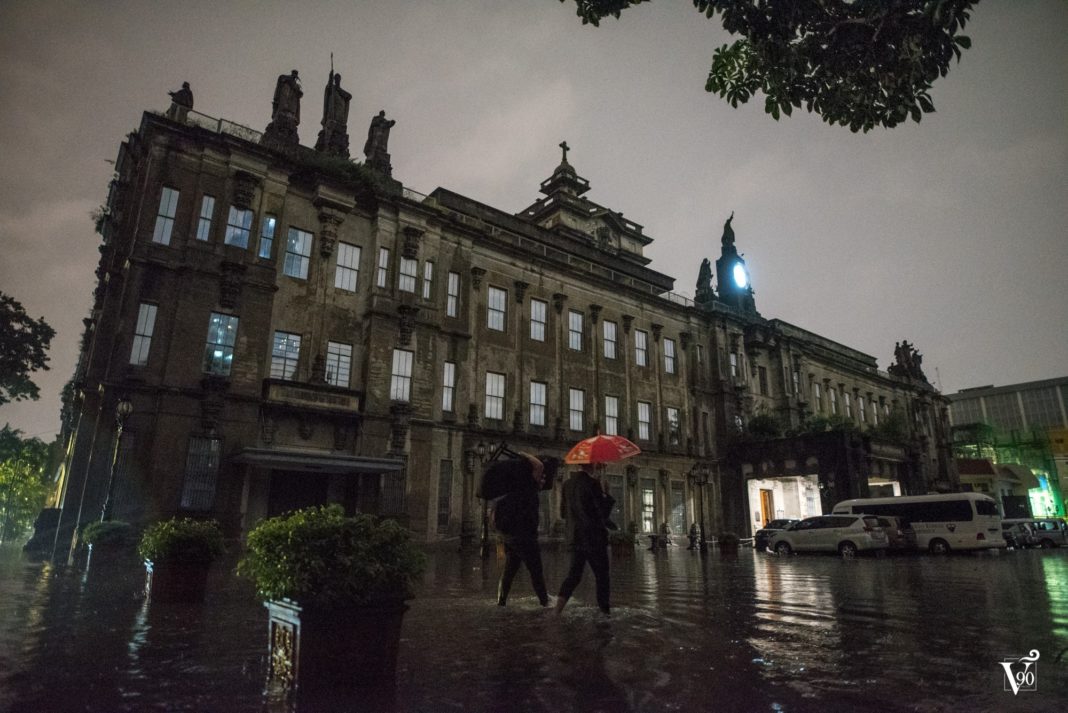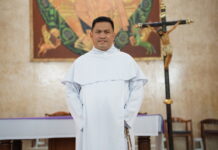WITH THE start of the academic year comes torrential rain that often results in flooding in UST and the Sampaloc district of Manila.
Discussions on how to solve the flooding problem without disrupting the University’s operations and sacrificing its heritage were revived, when photos posted by the Varsitarian showing flooding on campus circulated in social media.
Thomasian historian Jose Victor Torres lamented that there has been no improvement in the flooding situation in the UST campus and its surroundings.
“There [is] no difference or improvement on the flood situation, but it is certain that in spite of the flooding, some areas easily drain the floodwaters because of the existence of esteros [which] serve as a natural drainage to remove floodwaters to the Pasig River,” Torres said in an interview with the Varsitarian.
He said the continuous development of the city had led to the reclamation of these esteros, blocking the flood drains.
“There have been some solutions, but because these are government projects, changes in administration led to the non-continuance of these projects,” Torres said.
Torres recalled the flood control project underneath España Boulevard in the 1950s and 1960s. He said the boulevard in front of UST is “literally hollow.”
“There used to be a storm drain tunnel that drains to the pumping station at Tanduay Street in Quiapo, but this drain has already been blocked and destroyed because of the buildings that were constructed over it,” Torres said.
In 2013, then public works secretary Rogelio Singson said the drainage system in the city, specifically around the University, was obsolete.
With UST standing on a 21.5 hectare property, the government wanted the Open Field as a catchment basin that could mitigate the flooding problem.
Singson proposed to dig a retarding tank the size of the UST Grandstand under the open field that would retain the water during heavy rains, and then pumped out to the waterways after the rains.
The University administration was quick to reject the proposal, citing security concerns and disturbance of campus activities. The University also wanted to protect the Open Field, which was declared a National Cultural Treasure in 2010.
The government did not submit a formal proposal nor a feasible scientific study for the proposed retarding tank under the Open Field.
It was only in 2016 that a scientific study was published by a group of scientists led by Alfredo Mahar Lagmay, a professor from the UP National Institute of Geological Sciences and executive director of Project NOAH, the country’s primary disaster management program.
He explained that street floods in Metro Manila “do not just occur anywhere, but are found at intersections of streets and creeks,” which means that they occur at the lowest portion of streets.
The most ideal solution to mitigate flooding in low-lying areas such España is to either elevate the road or to construct a retention basin large enough to accommodate the volume of flood water in the area.
As an alternative to the government’s proposal to dig a “flood catcher” under the Open Field, UST presented its plan to build its own catch basin in a different location — under Osmeña Drive between the Parade Ground and Benavides Park.
In an earlier report by Varsitarian on that same year, Rector Fr. Herminio Dagohoy, O.P. said that with the planned 10-meter-deep basin, the campus should be able to withstand two hours of continuous rain, with the water pumped out afterward for recycling.
Torres said: “UST can help in addressing the flood control problem with the cooperation of local and national government agencies, but it does not mean it will sacrifice its heritage.”
He pointed out that government properties in Manila can be used as catch basins, such as the lot near the LRT Legarda Station, but “the government refused to use it even though the area is closer to the Tanduay Station and is still part of the flooded areas.”
It was in 2010 when the National Commission on Culture and the Arts, National Historical Commission of the Philippines and the National Museum of the Philippines declared UST’s Open Field, Main Building, Central Seminary and the Arch of the Centuries as National Cultural Treasures.
A National Cultural Treasure is “a unique cultural property found locally, possessing outstanding historical, cultural, artistic and/or scientific value” and “shall not be relocated, rebuilt, defaced or otherwise changed in a manner, which would destroy the property’s dignity and authenticity, except to save such property from destruction due to natural causes,” according to the National Cultural Heritage Act.
The UST Open Field has been graced by visits of three Popes: Blessed Paul VI in 1970, St. John Paul II in 1981 and 1995 and Pope Francis in 2015.













